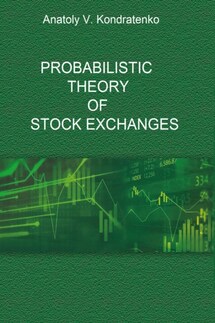Probabilistic Economic Theory - страница 21
We can build the price economic space of any dimension L in the same way. In spite of its apparent simplicity, the introduction of the formal economic price space is of conceptual importance as it allows us to describe behavior of market agents in general mathematical terms. It represents realistic occurrences, as setting out their own price for goods at any moment of time t is the main function or activity of market agents. It is, in fact, the main feature or trajectory of agents’ behavior in the market. Let us stress once again that it is our main goal to learn to describe these trajectories or the distributions of price probability connected with them. It is impossible to do this in a physical space. For example, we can thoroughly describe movement or the trajectory of a seller with goods in physical space, especially if they are in a car or in a spaceship. However, this description will not supply us with any understanding of their attitude towards the given goods; nor will it explain their behavior or value estimation regarding the goods as an economic agent.
Fig. 2. The economic one-dimensional price space for the one-good market economy.
Fig. 3. The economic two-dimensional price space for the two-good market economy.
Within the problem of describing agents’ behavior in the market, the role of the good prices P as independent variables, or a coordinates P is considered here to be in many situations a unique one for market economic systems. In these cases we can study market dynamics in the economic price spaces. But market situations occur fairly often in which we need to explicitly take into account the independent good quantity variables Q (the bold Q will designate below all the L quantity coordinates) and consequently to describe economic dynamics in the economic 2×L-dimensional price-quantity spaces. In these scenarios, we can imagine that the whole economic system is located in the multi-dimensional price-quantity space as it is displayed in Fig. 4. We have already used many aspects of this idea naturally when discussing classical economics. We will address any concerns in the upcoming chapters.
Fig. 4. The graphical model of the many-good, many-agent market economy in the economic multi-dimensional price-quantity space. It is displayed schematically in the conventional rectangular multi-dimensional coordinate system [P, Q] where, as usual, bold P and Q designate the price and quantity coordinate axes for all the goods. Again, our model economy consists of the market and the institutional and external environment. The market consists of buyers (small dots) and sellers (big dots) covered by the conventional sphere. Very many people, institutions, and natural and other factors can represent the external environment (cross – hatched area behind the sphere) of the market which exerts perturbations on market agents (pictured by arrows pointing from environment to the market).
3. The Market-Based Trade Maximization Principle and the Economic Equations of Motion
As we saw above in the example of the simplest classical economies, market agents actively make trade transactions, and there are no trade deals at all out of the equilibrium state. As the inclination of market agents’ action is to make deals, we can naturally conclude that market agents and the market as a whole strive to approach an equilibrium state that can be expressed as the natural tendency of the market to reach the maximum volume of trade. This fact can serve as a guide for using the market agents’ trajectories to describe their dynamics. Moreover, this fact gives us grounds to expect that equations of motion can be derived from the market-based maximization principle, used to describe these trajectories. Specifically, the main market rule “Sell all – Buy at all” can be regarded to some extent as a verbal expression of both the tendency of the market toward the trade volume maximum, and the principal ability to describe market dynamics by means of agent trajectories as solutions to certain equations of motion.







